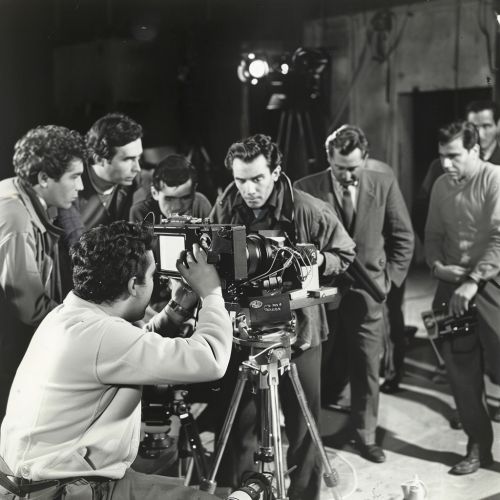George Sidney: Difference between revisions
(Created page with "== Early Life and Education == George Sidney was born on October 4, 1916, in Long Island City, New York. He was the son of Louis Sidney, a prominent Broadway producer, and Hazel Mooney Sidney. Growing up in a family deeply entrenched in the entertainment industry, Sidney was exposed to the world of theater and film from a young age. He attended the Professional Children's School in New York City, which catered to young performers and artists, providing him with a unique...") |
No edit summary |
||
| Line 11: | Line 11: | ||
In 1941, Sidney directed his first feature film, "Free and Easy," a comedy that showcased his ability to blend humor with engaging storytelling. This film marked the beginning of a successful career that spanned several decades. Sidney's breakthrough came with the 1945 musical "Anchors Aweigh," starring [[Gene Kelly]] and [[Frank Sinatra]]. The film was a critical and commercial success, earning Sidney an Academy Award nomination for Best Director. | In 1941, Sidney directed his first feature film, "Free and Easy," a comedy that showcased his ability to blend humor with engaging storytelling. This film marked the beginning of a successful career that spanned several decades. Sidney's breakthrough came with the 1945 musical "Anchors Aweigh," starring [[Gene Kelly]] and [[Frank Sinatra]]. The film was a critical and commercial success, earning Sidney an Academy Award nomination for Best Director. | ||
[[Image:Detail-93231.jpg|thumb|center|George Sidney directing a film on set, surrounded by actors and crew.]] | |||
== Major Works and Contributions == | == Major Works and Contributions == | ||
Revision as of 04:45, 22 June 2024
Early Life and Education
George Sidney was born on October 4, 1916, in Long Island City, New York. He was the son of Louis Sidney, a prominent Broadway producer, and Hazel Mooney Sidney. Growing up in a family deeply entrenched in the entertainment industry, Sidney was exposed to the world of theater and film from a young age. He attended the Professional Children's School in New York City, which catered to young performers and artists, providing him with a unique educational environment that balanced academic rigor with artistic training.
Career Beginnings
Sidney's career in the entertainment industry began in the early 1930s when he started working as an assistant director at MGM. His early work involved assisting established directors and learning the intricacies of film production. Sidney's talent and dedication quickly earned him recognition, and he was soon given opportunities to direct short films and documentaries.
Rise to Prominence
In 1941, Sidney directed his first feature film, "Free and Easy," a comedy that showcased his ability to blend humor with engaging storytelling. This film marked the beginning of a successful career that spanned several decades. Sidney's breakthrough came with the 1945 musical "Anchors Aweigh," starring Gene Kelly and Frank Sinatra. The film was a critical and commercial success, earning Sidney an Academy Award nomination for Best Director.

Major Works and Contributions
Musicals
Sidney is perhaps best known for his work on musicals, a genre in which he excelled. His notable musicals include "The Harvey Girls" (1946), "Show Boat" (1951), and "Kiss Me Kate" (1953). "Show Boat," based on the novel by Edna Ferber, was particularly significant as it addressed complex themes such as racial prejudice and social change, making it a landmark in American musical cinema.
Comedies and Dramas
In addition to musicals, Sidney directed a variety of comedies and dramas. His versatility as a director is evident in films like "The Three Musketeers" (1948), a swashbuckling adventure, and "Scaramouche" (1952), a historical drama. Sidney's ability to navigate different genres and styles contributed to his reputation as a skilled and adaptable filmmaker.
Technical Innovations
Sidney was known for his innovative use of technology and special effects in filmmaking. He was one of the early adopters of Technicolor, a color motion picture process that revolutionized the industry. His film "Anchors Aweigh" featured a groundbreaking sequence in which Gene Kelly danced with the animated character Jerry Mouse, showcasing Sidney's willingness to push the boundaries of traditional filmmaking techniques.
Influence and Legacy
George Sidney's influence on the film industry extends beyond his directorial achievements. He was a founding member of the DGA and served as its president from 1951 to 1959. During his tenure, he advocated for the rights and recognition of directors, helping to shape the professional landscape of Hollywood.
Sidney's films have left a lasting impact on both audiences and filmmakers. His ability to combine entertainment with artistic expression set a standard for future generations of directors. Many of his works are considered classics and continue to be studied and appreciated for their technical prowess and storytelling excellence.
Personal Life
Sidney married three times throughout his life. His first marriage was to Lillian Burns, an MGM talent scout, in 1942. The couple had two children before divorcing in 1951. Sidney's second marriage was to Jane Robinson, a former actress, in 1951. They had one child together before divorcing in 1966. His third marriage was to Corinne Cole, a model and actress, in 1966, which lasted until his death.
Awards and Honors
Throughout his career, Sidney received numerous accolades for his contributions to the film industry. In addition to his Academy Award nomination for "Anchors Aweigh," he was honored with a star on the Hollywood Walk of Fame in recognition of his achievements. Sidney was also awarded the DGA Lifetime Achievement Award in 1990, a testament to his enduring impact on the field of directing.
Later Years and Death
In his later years, Sidney continued to be involved in the film industry, albeit in a less active capacity. He served as a mentor to young filmmakers and remained a respected figure in Hollywood. George Sidney passed away on May 5, 2002, in Las Vegas, Nevada, at the age of 85. His legacy lives on through his films and the many directors he inspired.
